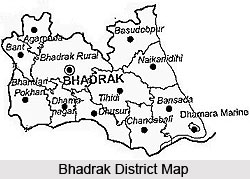 The legendary history of Bhadrak dates back to the age of the Puranas when Orissa achieved thriving maritime and agrarian prosperity. The antiquity of Bhadrak is eloquently confirmed by the gigantic tank of the Asura, the Buddhist remnants and the Buddhist caves of the 7th and 8th century, discovered in the villages adjacent to the core town of Bhadrak.
The legendary history of Bhadrak dates back to the age of the Puranas when Orissa achieved thriving maritime and agrarian prosperity. The antiquity of Bhadrak is eloquently confirmed by the gigantic tank of the Asura, the Buddhist remnants and the Buddhist caves of the 7th and 8th century, discovered in the villages adjacent to the core town of Bhadrak.
As far as the history of Bhadrak is concerned, king Mukunda Dev was the last sovereign indigenous ruler of Bhadrak, who was then the master of the major section of Orissa. But the freedom of Orissa was curbed when the erstwhile king Mukunda Dev was defeated and finally lost his life in 1568. The Muslim population began to settle in the pockets of Bhadrak district around the year 1575 following the discomfiture of the Afghans under Usman at the hand of raja Man Singh.
The episode of Muslim dynasty in the history of Bhadrak is deciphered from Ain-I- Akbari of Abul Fazal. As the history of Bhadrak depicts, during the Muhgal period Bhadrak survived as a Subha under the Nawabs of Bengal. When the majestic Muhgals diminished from the political scenario of Bhadrak, the zone consisted of a few principalities like Kanika, Ampo and Agarapada, with a few administrative sub-units called Chowparhies such as Kubera, Talapada, Nadigaon, Kasimpur, Kurigaon, Bindha etc., which came under the sway of the Rajput Kshatriya chiefs. In course of time Bhadrak has passed on to different hands and colonized by different dynasties till the British occupied the entire region of Orissa, with the grant of Diwani.
The history of the British era in Bhadrak commenced with the occupation of Orissa by the British and Balasore and Cuttack, remained as one of the two administrative divisions of Orissa. When Balasore was fragmented in June 1828 with the status of a separate district, the present Bhadrak existed as one of the sub division of the Balasore district with an Assistant Magistrate cum Deputy Collector as the Sub divisional head.
The historical records of Bhadrak relate that Bhadrak became a prominent seat during the era of National Struggle against the British. It was the vanguard of the national politics in 1920, when the non Co-operation Movement was initiated with the clarion call of Gandhiji, which soon assumes a national color. The non co-operation movement in Bhadrak as its history depicts, is marked with a huge popular support. Imbibed with the nationalistic fervor propagated by Gandhiji, non co-operation in Bhadrak involve an enormous public participation. As the historical records of Bhadrak narrate, several mass rebellions against the British breed out in the pockets of Bhadrak district. In 1922, started the historical mass movement of Kanika, in the bosom of Bhadrak, which for the time being was crushed by the British forces. But the tenants of Kanika, with the leadership of Chakradhar Behera, triumphed the rebellion. After the gigantic mass movements lead by the people of Bhadrak, ardent political fervor swing the political scenario of Bhadrak and it was again the hotbed of politics during the Civil Disobedience movement.
In the historic Quit India Movement, Bhadrak took a leading part. Muralidhar Panda imbibed the inhabitants of Bhadrak to blaze their patriotic zeal with the fire of revolution against the British. The tenants raise movements against the British in the adjacent areas of Bhadrak. At Eram on 28th September 1942, in an enclosed place nearly 40 persons were stabbed ruthlessly by the British troops, which was the replica of Jallianwalabagh Massacre. The history of Bhadrak is inseparable with the history of Indian Struggle for Independence.
Since Bhadrak was the hotbed of Indian Struggle for Independence, it was the seat of contemporary politics, education and culture, right from the British imperialism in India. As is evident from the history of Bhadrak, in the post independence period, Bhadrak keeping on pace with the changing scenario, retains the aroma of its traditionality in the multifarious progress of Education, Industry, Agriculture, Trade and commerce






